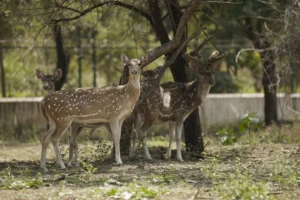Planning a trip to Tadoba Tiger Reserve? Deciding on the duration of your stay and the best time to visit is crucial for an optimal wildlife experience. Let’s break down the factors that will help you plan the perfect Tadoba getaway.
How Many Days Are Sufficient in Tadoba?
- Two to Three Days for a Wholesome Experience: Tadoba is expansive, and to truly absorb its diverse landscapes and wildlife, plan for a stay of at least two to three days. This time frame allows you to go on multiple safaris, increasing your chances of encountering different species and witnessing various behaviors.
- Multiple Safaris Mean More Wildlife Encounters: Tadoba offers both morning and evening safaris. A combination of both increases your chances of spotting elusive animals like tigers, leopards, and sloth bears. Different times of the day showcase distinct facets of the park’s wildlife, providing a more comprehensive experience.
- Relax and Unwind: Beyond the safaris, having extra days allows you to soak in the tranquility of the surroundings. Take a leisurely stroll around your accommodation, savor the local cuisine, and immerse yourself in the charm of the nearby villages. A well-paced visit ensures you don’t miss out on the subtler but equally enriching aspects of Tadoba.
Best Time to Visit Tadoba
- Winter Months (November to February): The winter season is often considered the best time to visit Tadoba. The weather is pleasant, with temperatures ranging from cool to mild. The dry vegetation during this period improves visibility, making it easier to spot wildlife. The months of December and January, however, can get quite chilly, so pack accordingly.
- Summer (March to May): Summer brings a burst of greenery to Tadoba. While temperatures start to rise, the park is vibrant with blooming flowers and lush foliage. Animals are frequently spotted around water bodies, providing excellent opportunities for wildlife enthusiasts. However, as the season progresses, the heat can become quite intense.
- Post-Monsoon (October): The post-monsoon period is a sweet spot, with the park coming alive after the rains. The vegetation is still lush, and the weather is relatively pleasant. It’s an excellent time to witness the park’s rejuvenation and spot a variety of animals.
Conclusion
In conclusion, spending two to three days in Tadoba provides a well-rounded experience, allowing you to explore the park’s diverse facets. Choosing the right time to visit depends on your preferences – whether you enjoy the cool winter breeze, the vibrant spring colors, or the lush greenery post-monsoon. Regardless of when you go, Tadoba promises a memorable encounter with the untamed beauty of Maharashtra’s wildlife.







